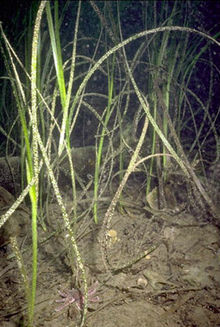What I want to do or know
I would like to know if Infragram and a camera that has been modified for near-IR imagery can distinguish between Eelgrass and other Aquatic plant species.
Background story
Marine Eelgrass (Zostera Marina) is a keystone and indicator species for coastal ecosystems in the coast of Maine. Its defoliation as a result of invasive Green Crabs (Carcinus maenas) is a key cause of acidification and other major threats to the entire marine ecosystem. By identifying Eelgrass in successive aerial surveys, scientists can measure its health or degradation as a key indicator of the overall stability of the ecosystem. Such a capability is currently only provided by costly sensors in manned overflights, the cost of which has limited such flights to once every two years and thus seriously limiting the usefullness of such data. If Eelgrass can instead be identified using the IR-filter technique with Infragram software, access to such critical data would be opened up considerably!

Part of the issue here would be the IR reflectance of the water's surface (due to the index of refraction of the water/air boundary), which I understand is pretty limiting of IR.
Typically the IR of NDVI is used as a control against a fixed and known system: the sun's emission of both IR and blue (or red) as compared to a plant's reflectance of each. With the water surface in the way of the sun's interface with the plant, normal NDVI might not be helpful.
If you were to bring your own IR source (most likely IR LED) under the water's surface and emit that, you might find that different plant species reflect that light source differently, while plants within the same species have a similar reflectance. Studying in-group versus cross-group differences is precisely what ANOVA is for!
However, if you're just using one color to measure reflectance of a well known source (LED), you might be fine using some frequency of green rather than dealing with IR.
You might be able to fake NDVI at night by shining your own IRGB LEDs or a broad spectrum light underneath the surface of the water. You're still looking to identify plant species rather than individual plant health, so ANOVA would be useful in measuring how dissimilar the readings are between plants within the species and between plants across species.
Reply to this comment...
Log in to comment
Eelgrass beds in New England have been traditionally mapped using normal color aerial photographs. Apparently the tricks of the trade are to have multiple photo dates throughout the growing season and to have some experience with what eelgrass looks like. The plants that are most commonly confused with eelgrass are seaweeds (macrophytic algae). The seasonal phenology of seaweeds can differ from that of eelgrass, making the multiple photo dates a key methodology.
Eelgrass is a green flowering plant and its photosynthetic pigments should respond to infrared and visible light just like land plants. Eelgrass grows in a range of water depths from where its leaves float at low tide to where its leaves remain several meters underwater. Near infrared light is absorbed by water more than is red light, but there could be enough transmitted through shallow water to add to the color signal from submerged plants. Having a fourth color band (NIR) could help distinguish eelgrass from other plant and non-plant substrates, but some experimentation would be needed. In water more than a couple of meters deep, NIR might not add anything to the signal.
Reply to this comment...
Log in to comment
If you were to bring your own IR source (most likely IR LED) under the water's surface and emit that, you november 2017 Calendar might find that different plant species reflect that light source differently, while plants within the same species have a similar reflectance. Studying in-group versus cross-group differences October 2017 Calendar is precisely what ANOVA is for!
However, if you're just using one color to measure reflectance of a well known source (LED), you might be fine using some frequency of green rather than dealing with IR.
Reply to this comment...
Log in to comment